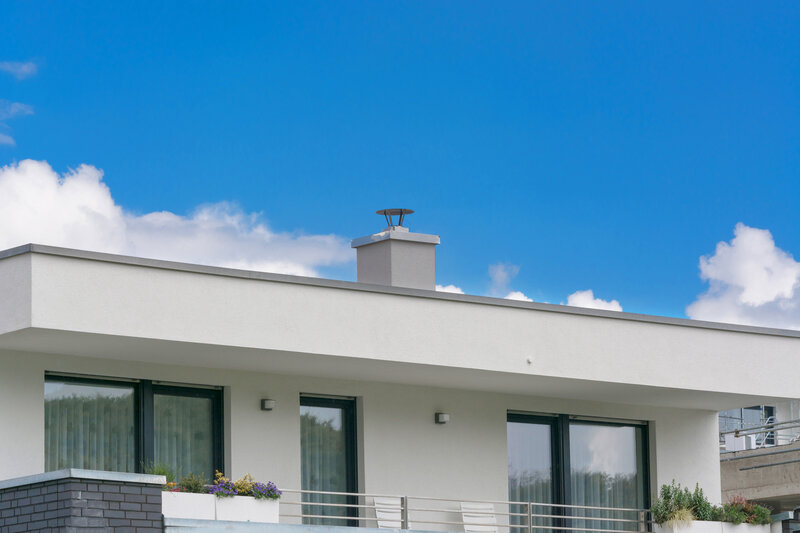
Flat roofs were popular in the modern home movement of the post-war era and continue to be popular for many contemporary residential and commercial building designs. However, as attractive as they are to those who appreciate streamlined architectural designs, flat roofs are prone to ponding water, detrimental to the home’s structure.
Addressing Ponding Water On A Flat Roof
According to the National Roofing Contractors Association, well and structurally sound flat roofs can handle standing water for up to 36 hours or so. Within this time, the slight slope (typically 10 degrees) and water drainage system should drain any post-storm moisture and direct it down and away from the roof and home. However, water that remains on a flat roof for 48 hours or longer is considered ponding water and should generate a call to your trusted local roofing contractor.
Causes Of Ponding Water
The most common causes of ponding water are:
Poor roof design
The best roofing materials in the world can’t make up for poor roof design. If the roof doesn’t have enough slope or wasn’t designed with your home’s location, lot orientation, or architectural design in mind, water doesn’t have a chance to drain correctly. Choosing a qualified and experienced licensed roofing contractor is the only way to guarantee a good roof design, especially critical for flat roofs.
Inadequate drainage system
Your roof’s drainage system, including the gutters and downspouts, is essential for roof design and function. Any corrosion, blocks, or damage can cause a backup that keeps roof water from draining quickly or efficiently. Cleaning gutters before the winter storm season and checking them after a storm to make sure they’re clear is an essential part of your roof maintenance tasks.
Building age and foundation settling
The roof slope is directly affected by the land and building below the roof. If sagging or tilting occurs, it can negatively impact the roof. This settling is more dramatic with flat roofs because it doesn’t take much to shift a 10-degree roof slope, which negatively impacts water runoff. Annual roof inspections are the best way to ensure your roof can do its job well.
Risks Of Ponding Water
Over time, ponding water evaporates. In the meantime, however, it is a threat to your home’s roof and the structural elements below. Repeat episodes of ponding or pooling water on the roof that last longer than 48 hours are:
- Major roof leaks
- Minor leaks or moisture infiltration that go unnoticed, causing thousands of dollars of interior structural damage
- Algae and moss growth on the roof (this risk increases in direct proportion to shade. The shadier the roof, the higher the risk of algae or mold growth)
- Mold and mildew inside the home
- More rapid aging and corrosion to roofing materials, leading to more frequent and expensive roof repairs and replacement.
Eliminate Ponding Water On The Roof For Good
Here are essential steps to prevent and eliminate ponding roof water for good.
Keep gutters and downspouts clean and clear. Inspect gutters and downspouts and keep them clear of debris. Cleaning gutters and downspouts is a relatively straightforward and safe DIY roofing maintenance task. Click Here for instructions. You can also build gutter cleaning/maintenance into your roofing maintenance contract or hire a qualified handyperson or roofer to get the job done twice a year.
Add more drain lines. Your roofer should be able to tell whether or not your roof has adequate drain lines. If your home is in an area more prone to rain and moisture accumulation, he may recommend adding more drain lines, or widening existing drain lines, to get water off the roof more quickly.
Repair the low spots. It may be that your roof is designed well, but low spots have occurred as the result of post-construction work by HVAC techs or the wear and tear of materials that support the work. If water pools are consistently in the same low spots, your roofer can repair those and make them flat again, allowing water to drain away as it should.
Install roof crickets. In some cases, the locations most prone to pooling water are those adjacent to roof penetrations, such as the chimney, vents, skylights, or other roof additions that obstruct water runoff. If this is where you notice the biggest collection of water on the roof, speak to a roofing contractor about roof crickets – ridged structures designed to divert rainwater around roofing obstructions, so it finds its way into the drain lines.
Replace your roof. If your roof is more than 15 years old, consider replacing it. Your new, professionally designed roof should take care of the problem, and our home will be better for it in terms of both moisture protection and energy efficiency.
Central Bay Roofing Eliminates Ponding Water Once & For All
If your roof sufferers from ponding water it’s time to meet the professionals at Central Bay Roofing. We’ll determine whether the fix is as simple as clearing or replacing gutters/downspouts, adding more drain lines or roofing crickets, or whether the roof design itself is the issue. Contact us to schedule your free, no-obligation consultation.
Ponding Water: The Downside Of A Flat Roof
Call Us On (510) 521-7334
Your Local Roofers Since 1978
We invite you to contact us today for an estimate on your roofing project.
1814 Clement Avenue Alameda, CA 94501
(510) 521-7334
info@centralbayroofing.comLicense: 435272 Class B, C-39
Site powered by RooferBoost
Copyright 2017 Central Bay Roofing and Restoration | Login
